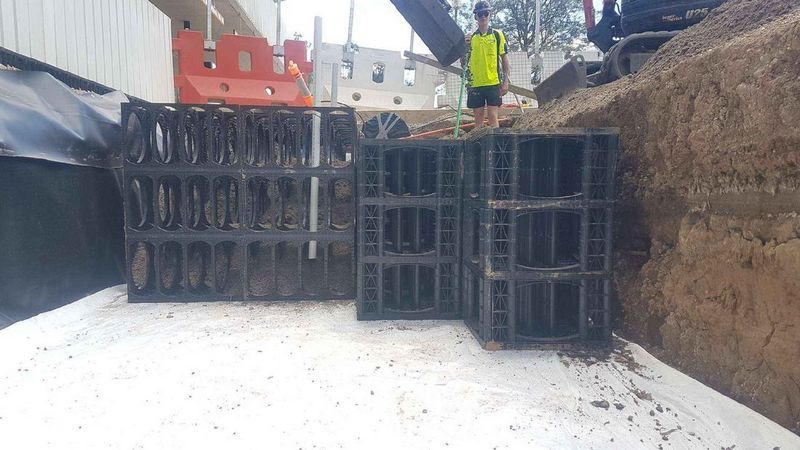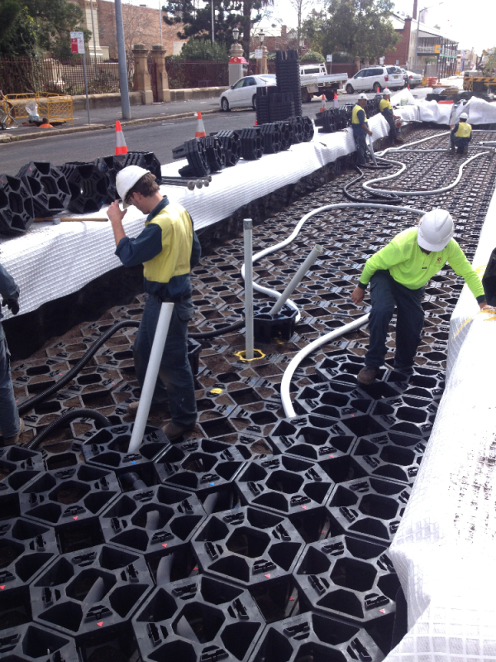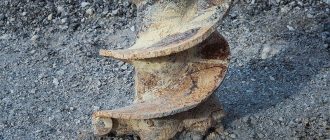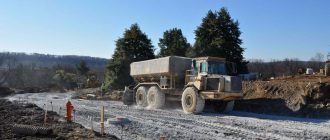
Using Structural Soil to improve Urban Environments
Urban environments can often be harsh and unforgiving, with little space for natural elements to thrive. However, thanks to the innovative use of structural soil, it is now possible to improve these environments and create more sustainable and vibrant urban spaces.
Structural soil is a specially engineered mixture of soil and stone that is designed to support the weight of heavy urban infrastructure, such as sidewalks, roads, and buildings. This unique blend allows for the growth of trees and other plants, providing much-needed greenery and natural beauty to urban areas.
By using structural soil, urban planners and architects can create spaces that are not only aesthetically pleasing, but also environmentally friendly. The soil’s unique composition allows tree roots to penetrate deep into the ground, providing them with the necessary stability and nutrients to thrive in even the most challenging urban environments.
Moreover, the use of structural soil helps to mitigate the effects of urban heat islands, which are areas of the city that are significantly warmer than the surrounding countryside. The ability of trees to grow in structural soil helps to cool the air around them, providing shade and reducing the overall temperature of the surrounding area.
In conclusion, structural soil is a game-changer for improving urban environments. By using this innovative mixture, urban planners can create spaces that are not only visually appealing, but also environmentally sustainable. With the ability to support the growth of trees and other plants, structural soil allows for the creation of vibrant and livable urban spaces that benefit both the city and its inhabitants.
Importance of urban environments
Urban environments play a crucial role in our daily lives. As our cities continue to grow, it is essential to prioritize improving these spaces to ensure a high quality of life for urban dwellers.
Structural soil is a valuable tool that can be used to transform urban landscapes. By using specially engineered soil, we can create urban environments that are not only aesthetically pleasing, but also sustainable and resilient.
The use of structural soil in urban planning and development can help to improve a wide range of urban infrastructure, including roads, sidewalks, and parks. This type of soil provides support for these structures while also allowing for the growth of vegetation. This is especially important in urban environments where space is limited and green areas are scarce.
By incorporating structural soil into urban design, we can create spaces that are not only functional but also beautiful. The plants and trees that are able to grow in this soil can provide shade, reduce noise pollution, and improve air quality. Additionally, these green spaces can promote physical and mental well-being, providing a much-needed respite from the hustle and bustle of city life.
Urban environments are constantly evolving, and it is essential that we find innovative solutions to improve them. By using structural soil, we can create urban spaces that are environmentally friendly, socially inclusive, and economically viable. With the growing focus on sustainability and the need for resilient cities, the use of structural soil is becoming increasingly important in urban planning and design.
The role of soil in urban environments
Soil plays a crucial role in improving urban environments, particularly when using structural soil. Structural soil refers to specially engineered soil that is designed to support pavement and other urban infrastructure while also providing an environment for tree roots to grow and thrive.
One of the main benefits of using structural soil in urban areas is its ability to improve soil quality. Traditional urban soils are often compacted and lacking in nutrients due to construction and development. However, structural soil is carefully engineered to have a higher porosity, allowing for better root penetration and water infiltration. This, in turn, promotes healthier tree growth and improves the overall urban environment.
In addition to improving soil quality, structural soil also plays a role in reducing soil erosion in urban areas. The compacted nature of traditional urban soils, combined with the lack of vegetation, can lead to increased soil erosion during heavy rain events. However, with the use of structural soil, the higher porosity and improved root growth help to stabilize the soil and prevent erosion.
Furthermore, structural soil helps to mitigate the urban heat island effect. Urban areas tend to have higher temperatures due to the vast amount of impervious surfaces such as concrete and asphalt. However, the use of structural soil allows for the planting of trees and vegetation, which helps to provide shade and cool the surrounding area. Not only does this create a more comfortable urban environment for residents, but it also helps to reduce energy consumption by lowering the need for air conditioning.
In conclusion, the use of structural soil plays a vital role in improving urban environments. By enhancing soil quality, reducing erosion, and mitigating the urban heat island effect, structural soil contributes to a healthier and more sustainable urban landscape.
Understanding structural soil
In urban environments, it is crucial to find ways to improve the quality of soil to promote healthier and more sustainable surroundings. One method that has proven effective is the use of structural soil.
Structural soil is a specially engineered material that combines a mixture of soil and rock particles, which creates a stable and load-bearing soil matrix. This unique composition allows for the growth of trees and plants in areas where traditional soil would not offer enough support, such as sidewalks, plazas, and road medians.
The key to the effectiveness of structural soil lies in its ability to provide adequate support for urban vegetation, while still allowing for root growth and water infiltration. The rock particles in the mixture create a network of void spaces that enable roots to penetrate and anchor the plants. Moreover, these void spaces also facilitate the movement of air and water through the soil, promoting healthier root growth and enhancing drainage.
Another advantage of structural soil is its durability. Its load-bearing properties make it resistant to compaction, which is a common issue in urban areas where soil is constantly subjected to heavy foot and vehicle traffic. Structural soil can withstand these pressures and maintain its stability, allowing for the longevity of urban green spaces.
Furthermore, the use of structural soil can provide a range of environmental benefits. By supporting the growth of trees and plants in urban areas, structural soil helps to improve air quality by removing pollutants and releasing oxygen. Additionally, the presence of vegetation can mitigate the urban heat island effect by providing shade and reducing surface temperatures.
| Provides support for urban vegetation | Improves air quality |
| Allows root growth and water infiltration | Reduces urban heat island effect |
| Resistant to compaction |
In conclusion, understanding structural soil is crucial for improving urban environments. Its unique composition and properties allow for the growth of trees and plants in areas with limited soil volume, supporting the creation of healthier and more sustainable cities.
Benefits of using structural soil
Structural soil is a specially engineered material that has been developed to improve urban environments. It is a combination of soil and angular aggregate that allows for the growth of trees and other vegetation in areas with limited soil volume.
One of the main benefits of using structural soil is that it provides a stable and supportive base for the growth of trees in urban settings. Traditional soil used for urban landscaping tends to be compacted and lacks adequate space for roots to grow. This can lead to stunted tree growth and an increased risk of trees toppling over in windstorms. Structural soil, on the other hand, is designed to be less compacted and provides a looser, more aerated environment for root development.
Another advantage of using structural soil is its ability to mitigate stormwater runoff. When rainwater cannot penetrate the ground due to compacted soil, it can lead to flooding and the transportation of pollutants into nearby bodies of water. By using structural soil, the water can infiltrate more effectively, reducing the risk of flooding and improving water quality.
Furthermore, structural soil can improve the overall health and longevity of trees in urban environments. By providing more space for root growth, trees are able to access essential nutrients and moisture, allowing them to thrive in spite of limited soil volume. This can help to create a greener, more inviting urban landscape and improve air quality by capturing carbon dioxide and releasing oxygen.
In summary, using structural soil offers numerous benefits for improving urban environments. It provides a stable base for tree growth, mitigates stormwater runoff, and enhances the overall health of urban trees. By utilizing this innovative material, cities can create more sustainable and aesthetically pleasing landscapes for their residents to enjoy.
Applications of structural soil in urban environments
Structural soil is a specially engineered type of soil that is designed to improve the growing conditions for trees and other vegetation in urban environments. Its unique composition allows it to provide support for pavements and other urban structures while also providing an adequate root zone for plants.
One of the primary applications of structural soil is in sidewalk and street tree planting. Traditional urban environments often lack adequate space for tree roots to grow, leading to tree health issues and limited tree survival rates. By using structural soil, urban planners and landscape architects can create a more suitable environment for street trees, allowing them to thrive and provide countless benefits to the community.
Another way structural soil is utilized in urban environments is through green roof installations. Green roofs are becoming increasingly popular in cities as a way to mitigate the urban heat island effect, improve air quality, and provide habitat for wildlife. However, the weight of the soil required to support vegetation on a roof can be a challenge. Structural soil offers a lightweight alternative, reducing the load while still providing the necessary support for plant growth.
In addition to street tree and green roof applications, structural soil can also be used in other urban landscaping projects. For example, it can be used to create planters and raised beds in public spaces such as parks and plazas. These areas can then be filled with vegetation, enhancing the aesthetic appeal of the urban environment while also providing environmental benefits.
Overall, the use of structural soil in urban environments offers a range of benefits. By improving the growing conditions for plants, it helps to create more sustainable and resilient cities. Whether it’s through street tree planting, green roofs, or other landscaping projects, structural soil provides a solution for incorporating nature into urban areas in a way that positively impacts both the built and natural environment.
Design considerations for using structural soil
When designing urban environments, using structural soil can greatly improve the overall functionality and sustainability of the space. Structural soil is specifically designed to support the weight of urban infrastructure while also providing space for roots to grow and access water and nutrients.
There are several important considerations when using structural soil:
- Load-bearing capacity: Structural soil should have the appropriate load-bearing capacity to support the weight of sidewalks, roads, and other urban infrastructure. It should be able to withstand the constant pressure without compacting or losing its structural integrity.
- Root space: One of the main benefits of structural soil is its ability to provide ample space for tree roots to grow and expand. The soil should be designed to accommodate these roots and allow them to access water, air, and nutrients, promoting healthy tree growth.
- Water drainage: Urban environments often struggle with excess water runoff. Structural soil should be designed to have proper drainage capabilities. This will help prevent waterlogged soil, which can lead to root rot and other plant health issues.
- Nutrient availability: Structural soil should also provide sufficient nutrients for plants to thrive. This can be achieved through the addition of organic matter and fertilizers to the soil mix.
- Monitoring and maintenance: Once structural soil is implemented, it is crucial to regularly monitor its condition and address any issues promptly. This may include checking for soil compaction, ensuring proper drainage, and providing supplemental nutrients as needed.
By considering these design considerations when using structural soil, urban environments can be improved and made more sustainable for both people and plants. With the right planning and maintenance, structural soil can contribute to the creation of healthier and more resilient urban landscapes.
Installation and maintenance of structural soil
When it comes to improving urban environments, using structural soil can greatly benefit the overall health and longevity of trees. However, proper installation and maintenance of this soil is essential to ensure its effectiveness.
The first step in installing structural soil is to properly prepare the site where it will be used. This includes removing any existing soil and debris, as well as preparing a stable base for the structural soil. It is important to ensure that the area is level and compacted before proceeding with the installation.
Once the site is prepared, the structural soil can be installed. This involves layering the soil in a specific manner to create the desired structure and stability. The soil should be compacted firmly to ensure its integrity and to prevent settling over time.
Maintenance of the structural soil is also crucial for its long-term success. Regular monitoring of the soil’s moisture content is important, as structural soil should be kept moist but not waterlogged. Adequate irrigation is necessary to ensure that the trees planted in the structural soil receive the necessary amount of water.
In addition to monitoring the moisture levels, it is also important to regularly inspect the structural soil for any signs of compaction or settling. If any issues are identified, remedial actions should be taken promptly to prevent further damage to the trees or the urban environment.
Overall, the installation and maintenance of structural soil is a critical aspect of creating a healthy and sustainable urban environment. By following the proper procedures and regularly monitoring the soil’s condition, the benefits of structural soil can be maximized, providing a stable and supportive growing medium for urban trees.
Case studies of successful urban projects using structural soil
Structural soil is a innovative soil mixture that is specifically designed for urban environments. It has been used in various urban projects to improve the quality of soil and create healthier and more sustainable urban environments.
One successful urban project that used structural soil is the High Line Park in New York City. The High Line Park is an elevated linear park built on a historic freight rail line. The park has transformed an abandoned industrial space into a vibrant green oasis in the heart of the city. Structural soil was used to create a stable and supportive base for the park’s plantings, allowing trees and vegetation to thrive in the urban environment.
Another example of a successful urban project using structural soil is the Vancouver Convention Centre in British Columbia, Canada. The convention centre is located on a waterfront site with limited soil depth and poor soil quality. To overcome these challenges, structural soil was used to create a stable and nutrient-rich substrate for the planted areas around the convention centre. This has resulted in lush and thriving green spaces that enhance the overall appeal of the facility.

The use of structural soil has also been successful in retrofitting existing urban environments. For example, the University of California, Davis implemented a project to improve the soil conditions in their urban campus. By using structural soil, they were able to create healthier and more resilient urban landscapes, improving the overall environmental quality of the campus.
In conclusion, structural soil has been proven to be a valuable tool in improving urban environments. These case studies demonstrate the effectiveness of using structural soil to create stable and supportive soil conditions for plants in challenging urban environments. By implementing structural soil in future urban projects, we can continue to improve the health and sustainability of our cities.
Challenges and Limitations of Using Structural Soil
Structural soil is a valuable tool for improving urban environments, but it also comes with its own set of challenges and limitations. Understanding these challenges is crucial for maximizing the effectiveness of using structural soil in urban areas.
| Weight and Compaction | Structural soil is heavy, which can be an issue for certain applications. Care should be taken to properly design and install the structural soil to avoid compaction and ensure proper drainage. |
| Root Penetration | Structural soil consists of large particles that can be challenging for roots to penetrate. It is important to select plant species with strong root systems that can withstand the compacted soil and provide adequate support. |
| Maintenance | Structural soil requires regular maintenance to keep it free from debris and prevent compaction. This may include periodic aeration, top-dressing, and soil testing to ensure proper nutrient levels and pH balance. |
| Cost | The installation and maintenance of structural soil can be more expensive compared to traditional soil options. However, the long-term benefits of improved urban environments may outweigh the initial costs in some cases. |
| Limited Availability | Structural soil may not be readily available in all areas, making it difficult to implement in urban projects. It is important to do thorough research and work with suppliers to determine the availability and cost of structural soil in your specific location. |
Despite these challenges, using structural soil can greatly improve urban environments by providing a stable and long-lasting foundation for trees and vegetation. By understanding and addressing these limitations, urban planners and landscape architects can effectively harness the benefits of structural soil to create healthier and more sustainable cities.
Future trends in improving urban environments with structural soil
As urban environments continue to expand and the demand for green spaces rises, it is crucial to find innovative ways to improve and maximize the use of available land. Structural soil has emerged as a promising solution for creating strong and healthy urban landscapes.
Structural soil is a specially formulated blend of soil, aggregates, and additives that is designed to support the growth of vegetation while also providing stability and structure. It allows trees and plants to establish deep roots, ensuring their long-term health and enhancing the urban environment.
One future trend in urban planning is the use of structural soil in vertical gardens and green walls. These structures can provide much-needed greenery in densely populated areas, improving air quality and providing visual appeal. By using structural soil, these vertical gardens can thrive and contribute to a healthier urban environment.
Another trend is the use of structural soil in urban tree planting. Traditional urban soils are often compacted and lacking in nutrients, which can hinder the growth of trees. By incorporating structural soil into tree planting projects, cities can create healthier urban forests that not only improve air quality but also provide shade, reduce noise, and promote biodiversity.
Furthermore, advancements in technology and research are leading to the development of new types of structural soil. These innovations aim to improve the water-holding capacity and drainage of the soil, ensuring the optimal growth of vegetation in urban environments. By using these advanced types of structural soil, cities can further enhance the health and resilience of their green spaces.
| Supports deep root growth | Use of structural soil in vertical gardens and green walls |
| Enhances air quality | Use of structural soil in urban tree planting |
| Reduces soil compaction | Advancements in technology and research |
| Promotes biodiversity | Development of new types of structural soil |
In conclusion, the future of urban environments lies in the improve using structural soil. It offers a sustainable and efficient way to create green spaces and enhance the overall well-being of cities. With the ongoing advancements and research in this field, the potential for improving urban landscapes with structural soil is vast.
Frequently asked questions:
What is structural soil?
Structural soil is a type of engineered soil that is specifically designed to support the weight of pavement and urban infrastructure while promoting healthy tree growth.
How does structural soil help improve urban environments?
Structural soil helps improve urban environments by providing necessary support for pavement and infrastructure, reducing the risk of damage. It also allows trees to thrive in urban areas, offering numerous environmental benefits such as improved air quality, reduced urban heat island effect, and enhanced aesthetics.
What are the components of structural soil?
Structural soil typically consists of a mixture of crushed stone or gravel and soil, along with additives such as sand and organic matter. This composition allows for proper drainage, root growth, and load-bearing capacity.
How is structural soil installed?
Structural soil is typically installed in specially designed tree pits or planting beds. The area is excavated, and the soil mixture is then compacted in layers to create a stable foundation. The tree is then planted in the soil, and remaining spaces are filled with traditional planting soil.
What are some key benefits of using structural soil in urban environments?
The use of structural soil in urban environments offers several key benefits, including improved tree health and growth, reduced infrastructure damage, enhanced stormwater management, increased urban biodiversity, and improved overall aesthetics of the urban landscape.





